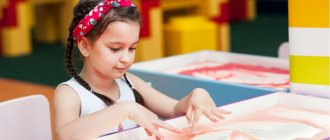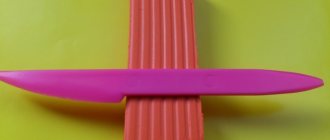Playing with sand during a walk in the middle group
Game activity for a walk with children 4-5 years old “Magic Sand”.
Author: Eremina Anastasia Nikolaevna, preschool teacher, teacher at GBDOU kindergarten No. 14, St. Petersburg.
The lesson is designed for preschool children, parents and educators. Play is the leading activity in preschool age. And playing with sand is one of the child’s natural activities. Sand is a natural and therefore very pleasant material, malleable and capable of taking on a variety of shapes. Playing with sand develops children's coordination of movements and new tactile sensations, fine motor skills of the fingers are formed and improved, and the development of fine motor skills of the hands contributes to the development of intelligence. Develops imagination and logical thinking. The properties of sand carry a certain mystery and mystery and can fascinate a person. Sand seems to “ground” negative energy. Manipulations with sand, both wet and dry, calm impulsive, overly active children and liberate tense, constrained and anxious children. Goal: to introduce children to sand as a play material. Objectives: - To introduce children and reinforce with them the basic properties of sand; — Development of fine motor skills, tactile sensations and coordination of movements; — Development of observation skills; — Development of attention, imagination and creative abilities of children; — Consolidation of motor skills; Materials:
sand (sandbox), water, flower, sandbox toys, ball, plastic fruits and vegetables, counting sticks.
Introductory part. Introduction to the topic of the lesson. The teacher asks all the children to come up and begins to tell (DO NOT READ) a fairy tale: “In a distant, unknown country, there lived a grain of sand “Krokha.” She wandered alone through the fields, through the meadows, across the plains, through the mountains. And I have never met other grains of sand. This upset Little One very much, because living alone is boring, scary and lonely. And then one day, high, high in the mountains, she met the wind. He picked up a grain of sand in his hands and spun it around like a whirlwind. But the grain of sand was not afraid, the baby just laughed. The mighty and great wind was surprised and asked: “Why are you laughing?” Usually everyone is afraid of me, trying to hide, but you are not! And the grain of sand answered: “I’ve been wandering around the world for a very long time, I’m bored, sad and lonely.” I am no longer afraid of anything or anyone, not even water. And when I met you, I was very happy, suddenly you would become my friend! The wind liked the sincere and kind grain of sand Tiny and decided to help her. He picked up a grain of sand and carried it to the land of sands.”
Teacher:
I also have a riddle for you, it will help you understand what we will meet today.
Children really need him, He’s on the paths in the yard, He’s at a construction site and on the beach, And he’s even melted in glass.
The children unanimously answer “SAND.”
Teacher:
yes, that’s right, we will get acquainted with sand.
Every day you see him, play with him, but you know so little about him. Let's see what sand can be? Main part. Teacher:
Now you and I will briefly turn into scientists and conduct several experiments.
Experimental games with sand “Properties of dry and wet sand.” Experiment 1.
Pour dry sand into your hands and “release” it like a stream of water. We will see that the sand is free-flowing. Then take a mold and pour sand into it, turn it over - the sand will spill out again and will not retain its shape.
Experiment 2.
Pour water into dry sand. Now let’s try to pick it up and pour it out like we did with dry sand. Why doesn't it work? The sand has become wet and cannot be poured out of the palms. But now it’s like plasticine, you can mold it into any shape until it becomes dry. We make sand figures with children. It is possible to compose a composition.
Experiment 3.
Plant a flower in dry and wet sand.
What will happen? Invite the children to plant a flower in dry sand first - nothing will work, the sand does not hold the flower - it crumbles. Then plant the flower in wet sand, now the flower will grow. Teacher:
what a great fellow you are, you carried out all the experiments.
Now we know that sand really is not afraid of either water or land. Let's play with the sand? Playing with sand “What kind of treasure?
The teacher selects one child with a counting rhyme and closes his eyes or takes him to the other side of the playground. Then, the rest of the children choose a toy and bury it in the sandbox. Afterwards, the child chosen by the teacher comes and slowly digs up the “treasure”. Based on the parts that open, the child must name the object. The game is repeated several times.
Examples of rhymes:
*** The cat sat on the window. She yawned: “It’s all the same, Even though I’m not sitting on the roof, I’m taller than everyone around me. And no one argues with me! Whoever I tell will drive!” *** Once upon a time, once upon a time, there were two cheerful geese with a grandmother: One is white, the other is gray - Two cheerful geese. One ran, the other jumped - Two funny geese. One could not fly, the other could not walk. If you don't believe it, you will drive. *** Behind the high mountains there is a Bear with pies. - Hello, Mishenka-friend, How much does the pie cost? - The pies are not for sale, they are put into the mouth themselves, but the one who takes them will drive with us. Teacher:
what a wonderful game we have!
Let's remember where you can find sand. Let's play with the ball. Ball game “Where does sand live?”
Children stand in a circle, the teacher in the center of the circle throws the ball to the children one by one and asks the same question: “Where does sand live?” Children must answer where sand can be found. Possible answers: in the sandbox; in water - river, sea, ocean; on the beach; at a construction site; on the street; in a desert; in asphalt; in glass.
Teacher:
how many interesting places you named, even I didn’t know so many.
Well done. And now it’s time for us to play, kids! Outdoor game “Catch the ball”.
The players form a circle, standing apart from each other at a distance of arms outstretched to the sides.
Using a rhyme, a driver is chosen: “Past the forest, past the dachas A red ball floated down the river.
A pike saw it. What is this thing? Grab, grab! Don't catch it. The ball surfaced again. He started to swim further. Come out, you can drive.” The driver takes a step back.
His place in the circle remains empty. The fifth child from the driver is given a large ball. The children say in unison: “One, two, three - run!” At this signal, the players begin to pass the ball to the right in a circle, and the driver runs behind the circle in the same direction, trying to reach his place before the ball reaches him. The game is repeated with a new driver, chosen using the same counting rhyme. Teacher:
We jumped, ran, and rested.
You must be very hungry? Let's go to the garden and plant our future harvest! Playing with sand “We came to the garden.”
We take plastic fruits and vegetables from the kindergarten to the playground in advance.
We invite the children to plant them one by one; the main condition is to describe the fruit/vegetable by shape, taste and color. Information to help: Carrots, beets, potatoes, turnips have fruits that grow in the ground, we don’t see them. And the stems are above the ground; Cucumber, cabbage, and zucchini have fruits that grow on the ground; Tomatoes, peas, peppers, and eggplants have fruits that grow on branches. Sample story: Onions are vegetables. Onions growing in the garden. It is small and round. The color of the onion is brown. Hard onion. It tastes bitter. Onions are added to soup and main courses. Onions are very useful!
Conclusion . Teacher
: what a great fellow you are, you did a great job! It's time to finish exploring the sand. I suggest you take counting sticks and build a fence out of them (stick the sticks in the sand), you will get a real road along which you can drive your cars or tractors.
Additional material for teachers, poems about sand:
A. Smetanin
My mother and I are on the beach We built a sand castle: Walls, stairs, loopholes, The tower rises steeply to the heights.
S. Kashlev
We play in the sandbox, We build a house out of sand, We get carried away, we don’t notice that our socks are full of sand. They brought water in a bucket, So that the house, which stood on a hillock, would not break down, We will water it with water. A. Poletaeva They brought us sand for the garden, I’m incredibly happy about this! I’ll play with him all day, make Easter cakes, sunbathe! I'll make holes in the sand, then I'll pour water in there. I’ll build a garage for cars, and a new house, and a hut! I don’t eat shortbread cakes, but why am I so small?! I. Fink Sandbox, sandbox! And there is sand in it, sand. Sandbox, sandbox! Let's go play, buddy. Sandbox, sandbox! We have a scoop in our hands. Sandbox, sandbox! We are scooping up sand. V. Bredikhin The sand lay, the sand was bored, probably for a hundred thousand years. He was terribly lonely, and it was bad. The songs of thunderstorms were not a joy, The rain from clouds was not a joy. He was bored in the heat, he was bored in the cold - The whole world was boring to the sand... And so for another hundred thousand years He would have remained despondent, But he was brought to us at dawn, And he is not bored, not at all, In the sandbox from now on.
We recommend watching:
Didactic games with sand for children 3-4-5 years old Games with sand in the preparatory group of a kindergarten Sand therapy as an innovative method in the work of a teacher with preschoolers Sand therapy in a preschool educational institution
Similar articles:
Scenario of summer fun for older preschoolers
ECD for cognitive development “I want to know everything about sand” for children of the middle group
Children wear aprons. Remember the rules for working with sand.
Experiment No. 1 “ Sand composition”
Material:
glasses with sand, sheets of white paper, magnifying glasses for each child.
Progress of the experiment:
Pour the sand from the cups onto a piece of paper and use a magnifying glass to examine the sand. What did you see, what is the composition of the sand? (grains, grains of sand, pebbles) Are there any similarities between grains of sand?
Conclusion
: sand consists of tiny grains of sand, they do not stick to each other.
Experiment No. 2
“Sand cone”
Material:
dry sand, funnel.
Progress of the experiment:
We take a handful of sand in our hand and let it flow in a stream, we have a cone. The cone will grow in height and be wide at the bottom. If you pour sand for a long time, it will spread out in different places. The movement of sand is very similar to the flow of a river. Let's blow on the sand, depict the wind, the sand particles will move from place to place.
Conclusion:
sand can move.
Educator:
sand can move, I invite you to move too.
Physical education minute
The waves are quietly rolling in, the children are swimming along the river. (swings with both hands at the same time.)
The sun is shining in the sky, there are no clouds in sight. (We rise on our toes.)
The children climbed ashore and decided to take a walk. ( The children are walking.)
We played and got tired, and sat down to rest ( Children run and sit on chairs.)
Experiment No. 3
“Sand in water”
Material:
glass of water, dry sand, spoon.
Progress of the experiment
: Place a handful of dry sand into a glass of water, but do not stir it. Let's look at what will happen. The sand will settle down, and sand dust can be seen on the surface of the water. If we stir the water, the sand dust will dissolve and color the water.
Conclusion
: sand is heavier than water, dust is lighter than water, so it remains on the surface and colors the water.
Experiment No. 4
“Sandbox”
Material
: sandbox with wet sand.
Progress of the experiment:
Let's
try
to make one out of dry sand. Did you manage to sculpt anything? Our crafts all fell apart. If you and I wet sand with water, what will happen? Is it possible to sculpt wet sand? Why do you think? Let's make Easter cakes with you.
Conclusion
: it is possible to sculpt from wet sand, but impossible from dry sand.
Stepashka
: Children, how many Easter cakes you made! How great it would be if the Easter cakes were colored!
Educator:
Children, do you think there is colored sand? I want to tell you and show you how to make colored sand yourself.
Recipe for making colored sand.
Material:
sand, starch, food coloring, glasses, water, basin, sand molds.
Progress:
Mix three cups of sand with two cups of starch and one cup of warm water. It is necessary to mix so that there are no lumps. What we have got, we need to divide it into parts and add food coloring. Let's make colored Easter cakes.
Sand Day in kindergarten, games during the walk “In the Land of Sand”
Children go outside and meet on the playground.
Host: Hello guys. Do you happen to know why we have gathered today? Children's answers
Host: It’s strange, but today there is no holiday. Or maybe one of you has a birthday? Children's answers
Presenter: no again...
the presenter notices a letter on the Christmas tree.
Well, well, well, what is this envelope?
Let's get a look. The presenter opens the envelope, and there is sand.
Presenter: strange letter, there is nothing there except...sand. And I realized, we need to see who it’s from. The presenter approaches a child who can read and asks who it is from to read it. A child reads “The Queen of Sand.” As soon as the child reads, the music immediately turns on and the Queen of Sand enters
Queen of Sand: hello guys!
I sent you a hint so that you would guess that today I am visiting your kindergarten. It looks beautiful here: there are houses, flowers and even sandboxes. Do you like to play with sand? Children's answers
Queen of Sand: great. But in my country everything is built from sand. Do you want to visit my country? Children's answers
Queen of Sand: If you're ready, then it's time for us to go.
Our journey will not be ordinary. You will go there on your own, together with your teachers. There are islands waiting for you with tasks that you must complete. If you do everything, I promise you a surprise upon your return. And the tests will begin right now. You need to solve riddles. Ready? Children's answers
Queen of Sand: Well done guys, you passed the first test. And they got tips to get to the place. Good luck!




